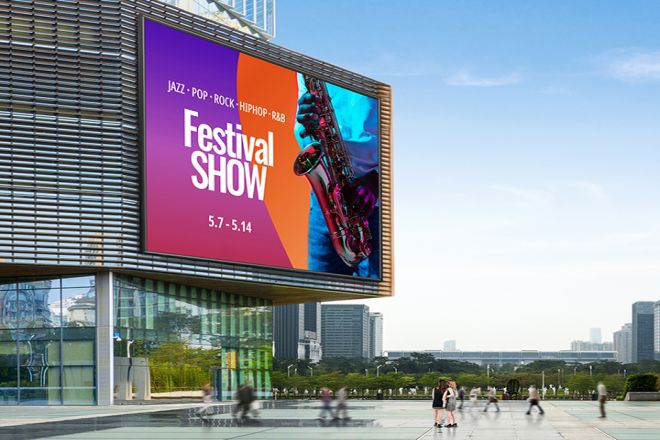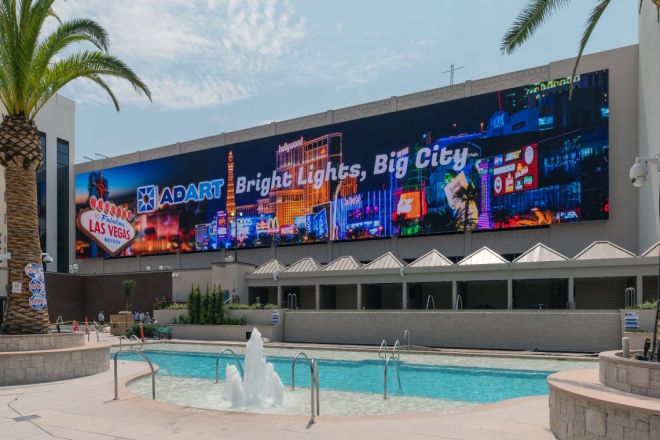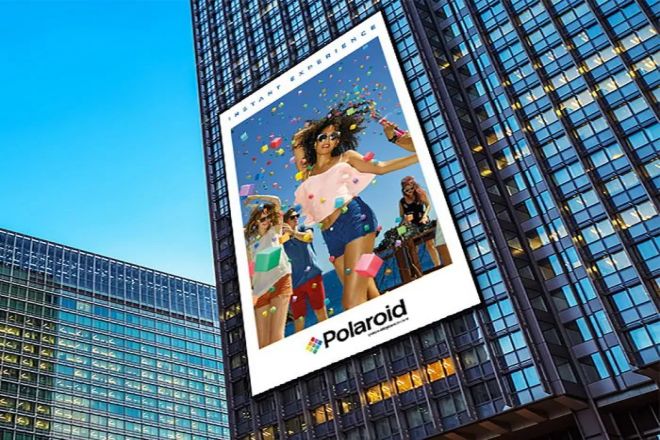소개

도시 이미지를 직관적으로 반영하는 도시 건축의 디자인 개념과 건축 스타일은 도시의 문화 유산과 역사적 유산을 반영할 뿐만 아니라, 도시의 현대화와 미래 개발 잠재력을 보여줍니다.
이러한 맥락에서 다음의 조합이 가능합니다. 야외 LED 디스플레이 도시 건축은 도시 건축에 새로운 시각적 경험을 가져다 줄 뿐만 아니라, 도시 문화의 확산과 경제 발전에 새로운 활력을 불어넣습니다.
1. 도시건물 내 옥외 LED 디스플레이의 기능적 역할
- 광고 및 정보 전달
옥외 LED 디스플레이는 도시 건물에서 광고 및 정보 전달에 중요한 역할을 합니다. 이는 상당한 장점이 있어 광고와 정보를 대중에게 빠르고 광범위하게 전달할 수 있습니다.
- 광고 매체로서 LED 디스플레이의 장점
현대의 광고 매체로서 LED 디스플레이 화면은 분명한 장점을 가지고 있습니다.
첫째, LED 디스플레이 화면은 고휘도, 고선명이라는 특성을 가지고 있어 낮에 빛이 강할 때에도 광고 내용을 선명하게 볼 수 있습니다. 둘째, LED 디스플레이는 동적 디스플레이를 지원하고 애니메이션, 비디오와 같은 멀티미디어 콘텐츠를 표시할 수 있어 광고를 더 매력적이고 시각적으로 강렬하게 만듭니다.
또한, LED 디스플레이 화면은 네트워크를 통해 원격으로 제어되어 다양한 고객의 요구에 맞게 광고에 대한 실시간 업데이트와 변경이 가능합니다.
- 홍보 효과를 높이기 위해 실시간으로 정보를 업데이트하세요.
실외 LED 디스플레이의 또 다른 중요한 기능은 정보의 실시간 업데이트입니다. 상업 광고, 공익 활동 또는 비상 알림이든 LED 디스플레이는 관련 정보를 빠르고 정확하게 표시할 수 있습니다. 이러한 실시간 특성은 정보 전달의 효율성을 개선할 뿐만 아니라 광고의 효과도 향상시킵니다.
LED 디스플레이를 통해 판매자는 광고 전략을 유연하게 조정하고, 신제품 정보를 적시에 공개하고, 홍보 활동을 실시하는 등 소비자의 관심을 끌 수 있습니다.
- 도시 풍경을 아름답게 하다
광고와 정보 전달의 기능 외에도, 옥외 LED 디스플레이는 도시 풍경을 아름답게 하고 도시 건물의 시각적 매력을 높일 수도 있습니다.
- LED 디스플레이 화면과 건축적 외관의 통합 설계
디자인 컨셉의 업데이트와 기술의 발전으로 LED 디스플레이 화면과 건축적 외관의 통합 디자인이 점점 더 많은 주목을 받고 있습니다.
디자이너들은 영리한 아이디어와 신중한 레이아웃을 통해 LED 디스플레이를 건물 외관에 통합하여 건물의 일부로 만들었습니다. 이 통합된 디자인은 건물을 더 아름답고 우아하게 만들 뿐만 아니라 LED 디스플레이의 시각적 효과와 장식적 가치를 향상시킵니다.
- 도시 건물의 시각적 매력을 향상시킵니다.
LED 디스플레이를 추가하면 도시 건축에 새로운 시각적 요소가 추가됩니다. 밤에 LED 디스플레이가 켜지면 건물이 밝혀져 매력적인 빛을 발산합니다. 이 독특한 시각적 효과는 사람들의 관심을 끌 뿐만 아니라 도시 건축의 시각적 매력을 향상시킵니다.
동시에, LED 디스플레이는 축제, 이벤트 등 다양한 상황에 맞게 변경 및 조정이 가능해 도시에 풍부하고 다채로운 시각적 경험을 선사합니다.
- 야간 조명 및 보안
위의 기능 외에도 실외 LED 디스플레이는 특정 야간 조명 기능도 갖추고 있어 밤에 건물의 안전성과 가시성을 향상시킬 수 있습니다.
- LED 디스플레이 조명 기능
LED 디스플레이 자체는 일정한 밝기를 가지고 있으며 건물의 조명 시설로 사용할 수 있습니다. 밤에 건물 주변의 조명이 꺼지면 LED 디스플레이의 조명 기능이 건물에 필요한 조명을 제공하여 어둠 속에서도 건물이 여전히 선명하게 보이도록 할 수 있습니다.
- 건물의 안전성과 야간 가시성을 향상시킵니다.
LED 디스플레이의 조명 기능은 도시의 야경을 아름답게 할 뿐만 아니라 밤에 건물의 안전과 가시성을 향상시킵니다. 빛이 어둡거나 가시성이 낮은 상황에서 LED 디스플레이의 조명은 보행자와 차량에 필요한 안내 및 경고를 제공하여 교통 사고 및 안전 위험 발생을 줄일 수 있습니다.
2. 옥외 LED 디스플레이와 도시 건축의 통합 설계

- 디자인 개념 및 원칙
옥외 LED 디스플레이와 도시 건축물을 통합 설계할 때 두 가지 사이의 조화와 통일성을 보장하기 위해 특정 설계 개념과 원칙을 따라야 합니다.
- 건축양식과의 조화와 통일성 강조
통합적 디자인은 먼저 LED 디스플레이의 외관 디자인, 소재, 색상 및 기타 측면이 건축 양식과 조화를 이루어야 합니다.
예를 들어, 모던 미니멀리스트 스타일의 건물에서 LED 디스플레이는 건물의 단순한 아름다움을 강조하기 위해 단순한 선과 색상을 사용할 수 있고, 클래식 스타일의 건물에서 LED 디스플레이는 디자인에 맞게 전통적인 패턴과 색상으로 디자인할 수 있습니다. 건축 스타일은 조정됩니다.
- 도시 환경의 전반적인 효과를 생각해 보세요.
건축 양식과 조화를 이루는 것 외에도 통합 설계는 도시 환경의 전반적인 효과를 고려해야 합니다. LED 디스플레이의 설치 위치, 크기, 밝기 등은 주변 환경에 맞게 조정하여 도시 환경에 부정적인 영향을 미치지 않도록 해야 합니다.
예를 들어, 번화한 상업 지역에서는 LED 디스플레이의 밝기를 적절히 높여 더 많은 사람들의 관심을 끌 수 있지만, 주거 지역에서는 주민의 삶에 미치는 영향을 줄이기 위해 밝기를 낮출 필요가 있습니다.
1) 사례 분석
- 국내외 LED 디스플레이 화면과 건축물의 성공적인 융합 사례를 소개합니다.
국내외에서 LED 디스플레이와 건물의 완벽한 통합을 보여주는 성공 사례가 많이 있습니다. 예를 들어, 상하이 진훙차오 국제센터 관광 엘리베이터 프로젝트의 LED 투명 스크린은 관광객의 파노라마 관광 요구를 충족할 뿐만 아니라 현대 건축의 기술적 특징을 충분히 보여줍니다.
시안 시하이 차이나타운 프로젝트에서 LED 투명 스크린은 건물과 완벽하게 통합되어 독특한 조경 효과를 형성합니다. 이러한 사례는 모두 LED 디스플레이와 건물의 통합 설계의 무한한 가능성을 보여줍니다.
- 디자인 특징과 효과를 분석합니다.
이러한 성공 사례의 디자인 특징은 주로 다음과 같습니다. 첫째, 건축 스타일과의 조화. 모던한 단순함이든 클래식한 스타일이든 LED 디스플레이는 건물과 완벽하게 통합될 수 있습니다. 둘째, 도시 환경의 전반적인 효과를 고려하여 LED 디스플레이가 도시 환경에 부정적인 영향을 미치지 않도록 합니다.
셋째, 첨단 기술과 소재를 사용하여 LED 디스플레이의 디스플레이 효과와 내구성을 보장합니다. 이러한 디자인 특징은 LED 디스플레이와 건물 간의 통합을 보다 자연스럽고 조화롭게 만들어 도시에 더 나은 시각적 경험을 제공합니다.
2) 디자인 트렌드 및 전망
- LED 디스플레이와 건물의 통합을 위한 미래의 디자인 트렌드를 예측합니다.
과학기술의 발전과 디자인 혁신으로 인해 향후 LED 디스플레이 화면과 건물의 디자인은 다음과 같은 추세를 보일 것으로 예상됩니다.
첫째, 건축물의 특성과 필요에 따른 맞춤형 설계 및 개인화 설계에 더욱 중점을 둡니다. 둘째, 환경 보호 및 에너지 절감을 위해 보다 환경 친화적인 재료 및 기술을 사용하여 에너지 소비를 줄입니다.
셋째, 상호작용성과 지능성에 더 많은 관심을 기울이고, 사물인터넷, 빅데이터 등의 기술을 통해 사용자와의 상호작용과 지능형 제어를 실현합니다.
- 가능한 혁신과 과제를 탐색해 보세요.
혁신 측면에서, 미래의 디자인은 LED 디스플레이를 건물의 다른 부분과 더욱 통합할 수 있습니다. 예를 들어, 건물 외벽, 창문 등과 함께 사용하여 독특한 시각적 효과를 만들 수 있습니다. 동시에 새로운 소재와 새로운 기술이 지속적으로 등장함에 따라 LED 디스플레이의 성능은 더욱 향상될 것입니다.
그러나 디자인을 통합하는 과정에서도 몇 가지 과제에 직면합니다. 첫 번째는 LED 디스플레이의 디스플레이 효과를 보장하는 동시에 건물 외관과 주변 환경에 미치는 영향을 줄이는 방법입니다. 두 번째는 디자인에서 에너지 절약 및 환경 보호 요소를 충분히 고려하는 방법입니다.
그리고 마지막으로 LED 디스플레이와 건물 사이의 안전을 보장하는 방법입니다. 연결 및 안정적인 작동. 이러한 과제는 디자이너와 엔지니어가 함께 협력하여 극복해야 합니다.
3. 옥외 LED 디스플레이가 도시 건축에 미치는 영향
1). 경제적 이익
옥외 LED 디스플레이가 도시 건축에 미치는 주요 영향은 경제적 이익에 반영됩니다.
- LED 디스플레이 스크린이 도시 건물에 가져다주는 상업적 가치:
효율적인 광고 매체로서 LED 디스플레이 화면은 많은 사람과 차량을 끌어들이고 도시 건물의 상업적 가치를 높일 수 있습니다.
상인은 LED 디스플레이를 통해 제품 광고, 홍보 활동 및 기타 정보를 표시하여 잠재 고객을 효과적으로 유치하고 판매 기회를 늘릴 수 있습니다. 또한 LED 디스플레이는 도시 건물의 추가 임대 수입을 창출하고 건물의 경제적 가치를 높일 수도 있습니다.
- 도시 경제 개발을 촉진합니다:
LED 디스플레이의 폭넓은 적용은 광고 산업의 발전을 촉진할 뿐만 아니라, 전자, 자재, 제조 및 기타 산업 등 관련 산업 사슬의 성장도 촉진합니다.
동시에 LED 디스플레이가 도시에 가져다주는 상업적 가치와 경제적 이익은 간접적으로 도시 전체의 경제 번영을 촉진합니다.
2) 사회적 혜택
옥외 LED 디스플레이가 도시 건물에 제공하는 사회적 혜택도 상당합니다.
- 도시의 이미지와 인기를 향상시키세요:
LED 디스플레이 화면은 세련된 광고 내용, 도시 홍보 영상 및 기타 정보를 표시하여 도시 건물의 외관과 분위기를 개선하고 도시 이미지를 향상시킬 수 있습니다.
동시에 도시의 명함으로서 LED 디스플레이 화면은 더 많은 관광객과 투자자를 유치하고 도시의 가시성과 영향력을 높일 수 있습니다.
- 지역 사회 상호 작용 및 문화 전파 강화:
LED 디스플레이 스크린은 커뮤니티 정보 공개 및 이벤트 홍보를 위한 플랫폼으로 사용되어 커뮤니티 주민 간의 상호 작용과 소통을 촉진할 수 있습니다. LED 디스플레이는 커뮤니티 문화, 역사, 예술 및 기타 콘텐츠를 표시함으로써 도시 문화를 계승하고 홍보하고 주민의 문화적 정체성과 소속감을 강화할 수도 있습니다.
3) 환경적 이점
3.1) 옥외용 LED 디스플레이도 환경 보호에 적극적인 역할을 합니다.
- LED 디스플레이의 에너지 절약 및 환경 친화적 특징:
LED 디스플레이는 기존 조명 시스템보다 에너지 소비량이 낮은 효율적이고 에너지 절약적인 LED 광원을 사용합니다.
동시에 LED 디스플레이 화면은 열을 덜 발생시켜 환경에 대한 열 오염을 줄입니다. 또한 LED 디스플레이의 긴 서비스 수명은 교체 및 수리 빈도를 줄이고 폐기물 발생을 줄입니다.
- 도시 환경에 대한 긍정적인 영향:
LED 디스플레이의 광범위한 적용은 종이 포스터와 전단지의 사용을 줄이고 자원 소비와 폐기물 배출을 줄이는 데 도움이 됩니다. 동시에 LED 디스플레이는 환경 보호 및 에너지 절약과 같은 공익 광고를 표시하여 대중의 환경 인식을 개선하고 도시 환경의 개선 및 지속 가능한 발전을 촉진할 수도 있습니다.
4. 도시건물 적용 시 옥외 LED 디스플레이 화면의 과제 및 대책 기술적 과제

1) 실외 LED 디스플레이가 직면한 주요 기술적 과제에는 밝기, 색상, 해상도와 같은 기술 지표의 균형과 최적화가 포함됩니다.
1.1). 도전 분석
밝기: 실외 LED 디스플레이는 낮에도 선명하게 보일 만큼 밝아야 하지만, 밝기가 너무 높으면 밤에 광공해 문제가 발생할 수 있습니다.
색상 및 해상도: 고품질의 시각적 경험을 제공하기 위해 디스플레이는 뛰어난 색상 재현 능력과 고해상도를 가져야 합니다. 그러나 이는 제조 비용과 에너지 소비도 증가시킵니다.
1.2). 솔루션 및 기술 발전:
지능형 밝기 조절 기술을 연구 개발하여 주변 조명 변화에 따라 디스플레이 화면 밝기를 자동으로 조절해 낮에는 선명도를 보장하고, 밤에는 광공해를 줄여줍니다.
디스플레이 기술 최적화: 에너지 소비를 줄이는 동시에 LED 칩의 발광 효율과 색상 정확도를 개선합니다.
고해상도 디스플레이 기술 소개: LED 디스플레이의 픽셀 밀도를 높여 더 높은 품질의 이미지 디스플레이를 실현했습니다.
2) 규정 및 정책
정부의 옥외 LED 디스플레이 규제 및 관리도 또 다른 중요한 과제다.
2.1). 도전 분석:
정부는 실외 LED 디스플레이의 설정, 내용, 밝기 등에 대해 엄격한 규제 요건을 갖고 있습니다.
승인되지 않은 실외 LED 디스플레이는 벌금, 철거 및 기타 처벌을 받을 수 있습니다.
2.2). 대책 및 제안:
관련 규정 준수: 야외 LED 디스플레이를 설치하기 전에 해당 지역의 규정과 정책을 이해하고 준수하세요.
합리적인 배치: 도시 계획 및 시설 배치에 따라 옥외 LED 디스플레이는 과학적이고 합리적으로 설치되어야 하며, 환경과 도시 이미지에 부정적인 영향을 미치지 않아야 합니다.
3) 시각공해 및 광공해
실외 LED 디스플레이를 과도하게 사용하거나 부적절하게 설치할 경우 시각 오염 및 광공해 문제가 발생할 수 있습니다.
3.1). 도전 분석:
지나치게 조밀한 LED 디스플레이는 도시 풍경을 어지럽게 만들 수 있습니다.
고휘도 디스플레이 화면은 야간에 광공해를 유발하여 주민의 삶과 생태환경에 영향을 미칠 수 있습니다.
3.2). 대책 및 제안:
수량 및 밀도 제한: 계획 및 관리 방법을 통해 실외 LED 디스플레이의 수량과 밀도를 제한하여 과도한 사용을 방지합니다.
밝기 조절 기술 소개: 앞서 언급했듯이, 지능형 밝기 조절 기술을 통해 광공해를 줄일 수 있습니다.
감독 및 법 집행 강화: 정부는 규정 준수를 보장하기 위해 옥외 LED 디스플레이에 대한 감독 및 법 집행을 강화해야 합니다.
대중 인식 제고: 홍보 및 교육 활동을 통해 시각 오염 및 광공해 문제에 대한 대중 인식을 높이고, 도시 환경과 주민의 삶의 질을 공동으로 유지합니다.
결론
요약하자면, 옥외 LED 디스플레이와 도시 건축은 분리할 수 없는 관계가 있습니다. 그것은 도시 건축에 밝은 외관과 변화하는 특성을 더할 뿐만 아니라 광고와 정보 전달을 위한 중요한 매체가 됩니다. 동시에 옥외 LED 디스플레이의 적용은 정부 정책에 의해 지원되어 도시에 사회적, 경제적 이익을 가져다주었습니다.
LED 디스플레이에 대한 더 많은 정보를 알고 싶다면, 우리에게 연락해주세요.
